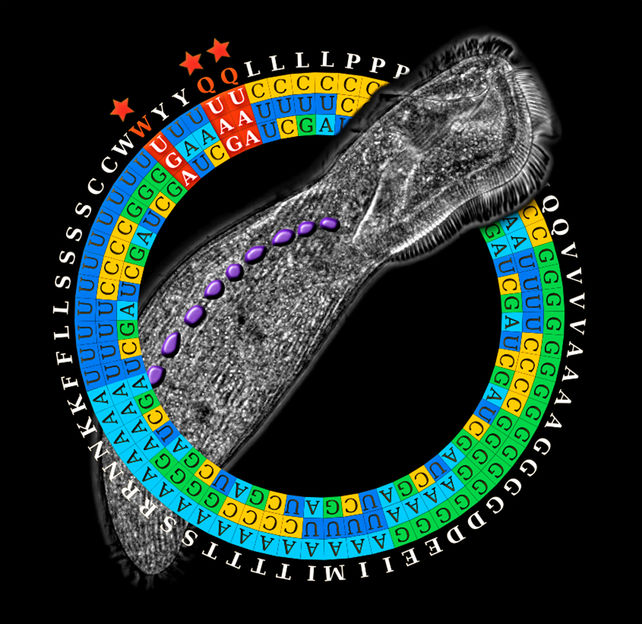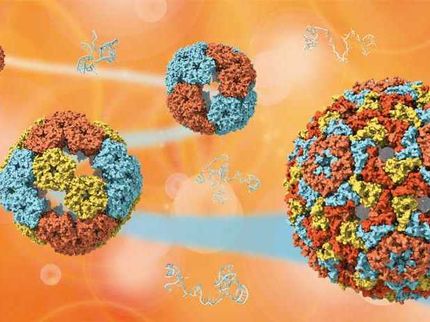Genetic code: Stop does not always mean stop
The genetic code is believed to be strongly conserved through evolution – from the earliest bacteria until today. But researchers from the Institute of cell biology of the University of Bern have now found two ciliate species where nature probably can be seen experimenting with the meaning of a codon, the building blocks of genetic communication.

Image of the ciliate Condylostoma magnum surrounded by concentric rings of genetic code. The red stars mark stop codons.
© UniBE/Estienne Swart
We all know language is ambiguous. One word can have several meanings, and different words can sound the same. Still communicating between humans is not a perfect mess – we have found ways to determine the meaning of ambiguous words reliably, by interpreting context. To make things even more complicated, language is a fluent, ever changing system – words can shift their meaning, human language can evolve.
Biology has a language to transmit information too, but experts usually refer to it as 'frozen'. The genetic code is something like a lingua franca of life, it is used everywhere from the simplest lifeforms to the human body. And it is exceptionally robust – since it has been developed some maybe 4 billion years ago, it does not seem to have undergone any evolutionary changes. Always three 'letters' of the DNA code for a specific amino acid, in total there are 61 'words' in this biologic language, plus three 'stop codons', the full stops of the biological machinery: end of sentence, stop building this protein now. There are no ambiguities. At least that is how it is written in all biological textbooks. But it’s a common fate of textbook dogmas: sooner or later they are proven wrong. Now researchers from the Institute of Cell Biology of the University of Bern have for the first time found multiple meanings of a codon. They have been studying ciliates, single cell organisms found in almost all waters. This discovery in the genetic code of ciliates represents an unknown intermediate step in evolution.
Dogma shown wrong
“Analysing the genetic code of many ciliate species, we found that two of them seemed to have stop codons everywhere in the code“ says Mariusz Nowacki, who was leading the research. For a ribosome, the cell machinery responsible for the translation of the code into proteins, it would look like sentences with full stops after each second word. The researchers realised quickly that these stop codons must have a different meaning altogether. They are coding for a protein building block – a feature not very common but found elsewhere in ciliates too, in which case stops are communicated differently. But then to their big surprise the researchers found that sometimes these same codons can indeed have a 'stop' meaning, telling the ribosomes very efficiently to end their job. Nowacki: “That led us to the conclusion that these codons are read in a context-dependent manner.” Further research showed that structural features at the end of the coding sequence have an influence on how the ribosome 'understands' the three letter word, but the exact mechanism of how it reads the context remains a bit of a mystery.
Ambiguous or not?
“We have been fighting about the term 'ambigouos', actually”, says Nowacki. Because the context gives clear hints how to interpret the codon, the biological language remains very clear – the cell machinery knows very well to deal with these multiple meanings. Just as we are not likely to confound a Volkswagen 'Golf' with the sport – the context always gives us enough information to tell the correct meaning.
For biologists, the findings are not only interesting because they show that simple truths almost certainly prove wrong when it comes to cellular mechanisms. Nowacki thinks that they have accidentally found a transitional stage in the evolution of this special cell mechanism, highlighting evolution 'as it happens'. Studying this anomaly could help biologists understand how in some species the genetic code might gradually change. Maybe the biological language is not as frozen as we always thought.

























































